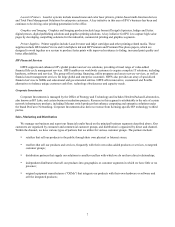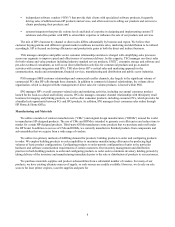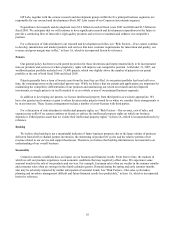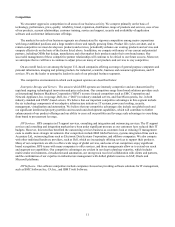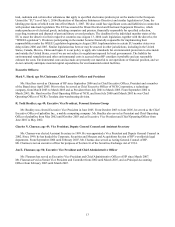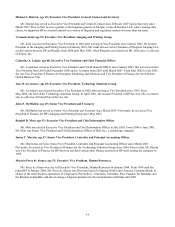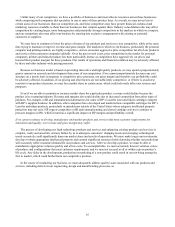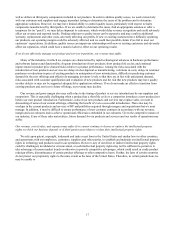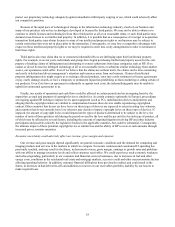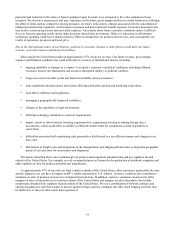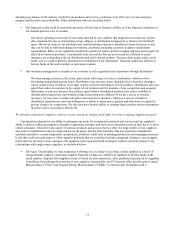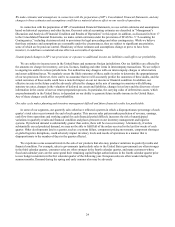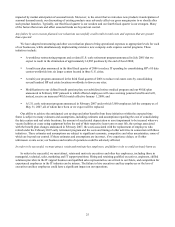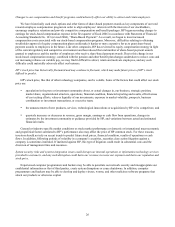HP 2007 Annual Report Download - page 30
Download and view the complete annual report
Please find page 30 of the 2007 HP annual report below. You can navigate through the pages in the report by either clicking on the pages listed below, or by using the keyword search tool below to find specific information within the annual report.Unlike many of our competitors, we have a portfolio of businesses and must allocate resources across these businesses
while competing with companies that specialize in one or more of these product lines. As a result, we may invest less in
certain areas of our businesses than our competitors do, and these competitors may have greater financial, technical and
marketing resources available to them than our businesses that compete against them. Industry consolidation also may affect
competition by creating larger, more homogeneous and potentially stronger competitors in the markets in which we compete,
and our competitors also may affect our business by entering into exclusive arrangements with existing or potential
customers or suppliers.
We may have to continue to lower the prices of many of our products and services to stay competitive, while at the same
time trying to maintain or improve revenue and gross margin. The markets in which we do business, particularly the personal
computer and printing markets, are highly competitive, and we encounter aggressive price competition for all of our products
and services from numerous companies globally. Over the past several years, price competition in the market for personal
computers, printers and related products has been particularly intense as competitors have aggressively cut prices and
lowered their product margins for these products. Our results of operations and financial condition may be adversely affected
by these and other industry-wide pricing pressures.
Because our business model is based on providing innovative and high quality products, we may spend a proportionately
greater amount on research and development than some of our competitors. If we cannot proportionately decrease our cost
structure on a timely basis in response to competitive price pressures, our gross margin and therefore our profitability could
be adversely affected. In addition, if our pricing and other factors are not sufficiently competitive, or if there is an adverse
reaction to our product decisions, we may lose market share in certain areas, which could adversely affect our revenue and
prospects.
Even if we are able to maintain or increase market share for a particular product, revenue could decline because the
product is in a maturing industry. Revenue and margins also could decline due to increased competition from other types of
products. For example, refill and remanufactured alternatives for some of HP’ s LaserJet toner and inkjet cartridges compete
with HP’ s supplies business. In addition, other companies have developed and marketed new compatible cartridges for HP’ s
LaserJet and inkjet products, particularly in jurisdictions outside of the United States where adequate intellectual property
protection may not exist. HP expects competitive refill and remanufacturing and cloned cartridge activity to continue to
pressure margins in IPG, which in turn has a significant impact on HP margins and profitability overall.
If we cannot continue to develop, manufacture and market products and services that meet customer requirements for
innovation and quality, our revenue and gross margin may suffer.
The process of developing new high technology products and services and enhancing existing products and services is
complex, costly and uncertain, and any failure by us to anticipate customers’ changing needs and emerging technological
trends accurately could significantly harm our market share and results of operations. We must make long-term investments,
develop or obtain appropriate intellectual property and commit significant resources before knowing whether our predictions
will accurately reflect customer demand for our products and services. After we develop a product, we must be able to
manufacture appropriate volumes quickly and at low costs. To accomplish this, we must accurately forecast volumes, mixes
of products and configurations that meet customer requirements, and we may not succeed at all or within a given product’ s
life cycle. Any delay in the development, production or marketing of a new product could result in our not being among the
first to market, which could further harm our competitive position.
In the course of conducting our business, we must adequately address quality issues associated with our products and
services, including defects in our engineering, design and manufacturing processes, as
16



